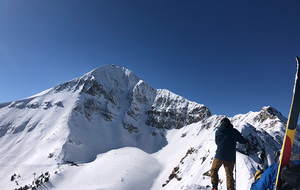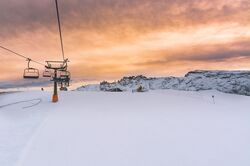Avant Skis: Big Sky Resort Overview
Bigger than big, Big Sky features in the top five resorts in North America for skiable acres and vertical drop. It spans 5,850 skiable acres and drops 4,350 vertical feet from the summit of Lone Mountain. Despite it’s size, the resort is easy to navigate with well placed, modern chairlifts. The resort receives 400+ inches of snowfall annually and between storms there’s ample wind buff created by frequent, strong west winds. Between the snowfall and elevation, Big Sky tends to stay open through late April.
Big Sky’s couloirs, chutes and bowls are unrivaled by North American resorts. For the 2020 – 21 winter, the resort coined the triple black diamond rating to signify their most extreme runs. Don’t let the extreme stuff scare you though, there’s also plenty of intermediate and beginner terrain – groomers as long as Montana’s rivers.
Change is underway through the resort’s ambitious Big Sky 2025 master plan with upgraded lifts and improvements to the base village. Hotel options still remain limited and pricey. We recommend reserving an Airbnb or VRBO. The après scene is on the rise with new bars and restaurants at the resort and in the nearby Town Center. We reccommend spending about a week to tackle this massive mountain. Big Sky offers 5 or 7 days on the Ikon Pass and 2 days on the Mountain Collective.
Quick Take
Let’s Go
- The most extreme terrain in North America within the ropes. Experience bucket list chutes, bowls, and couloirs, including the notorious Big Couloir
- Home to the most advanced chairlifts including the Swift Current 6, the fastest lift in North America and 8‑pack, Ramcharger. Both have heated seats and weatherproof, blue bubbles
- Major resort upgrades are underway with new restaurants and bars in the Mountain Village and hotel renovations
- Lift lines are short and there’s plenty of parking
Hesitations
- Effective winter of 2021⁄22, a separate pass is required to ride the Lone Peak Tram. Details on tram access can be found here.
- Lodging options at the base and in town are limited and expensive
- The town and the base of the mountain are ~15 minutes apart by car
- The upper mountain is very exposed and as a result, frequently closed
- The nearest airport, Bozeman International (BZN), is ~1 hour away and serviced by limited direct flights
Insider Tips
- During busier days, try to stick to the mid-mountain or peripheral lifts including Challenger, Lone Tree, Thunder Wolf, Shedhorn, and Dakota. Avoid the lifts that tend to be most crowded — Ramcharger, Swift Current, and Six Shooter
- If you plan to ride the Lone Peak Tram, arrive at the mountain at least 30 minutes before opening to secure a spot one of the first tram rides
- On clear days, follow the sun for the best snow. Spend the morning on the South Face, mid-day on the front side, and end on the north side in Moonlight Basin
- Spend a night in Bozeman and a day skiing Bridger Bowl. This local’s mountain is a gem with cheap lift tickets and a low-key vibe
- Try nordic skiing on Big Sky’s vast network of groomed trails. Or visit Yellowstone National Park, ~1.5 hours drive from Big Sky
Trail Map
For an in-depth breakdown of Big Sky’s terrain, head to our Mountain Guide. Top trails and mountain stats included.

Getting To & Around

Big Sky is located in the Madison Range of southwestern Montana. It’s an hour drive from Bozeman. We prefer to have a car. During the winter, Bozeman Yellowstone International Airport (BZN) has direct flights from 19 U.S. locations, including Boston, New York, Chicago, Denver, Salt Lake City and Los Angeles.

